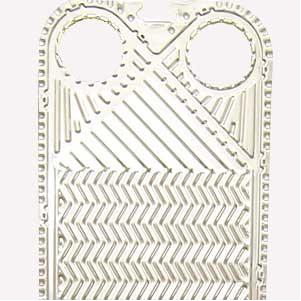

Plate plate material
Plate heat exchanger plate material commonly used in the following categories: Hastelloy C-276 This is an expensive ultra low carbon Ni (57%) - Cr () - () - (Mo) alloy - the main species in the C nickel base alloy. Hastelloy is a registered trademark of the Cabot Co. inc.. Abroad, began production in 1960s, has more than 55 thousand tons for various industries, has a good corrosion resistance effect in low PH medium is almost not affected by Cl; excellent corrosion resistance to various concentrations of sulfuric acid, can be used for one of the few hot concentrated sulfuric acid; widely used in organic acid (such as formic acid, acetic acid HF), high temperature acid and hydrochloric acid of certain concentration (< = 40%, phosphate (less than 50%); chloride, fluoride and organic solvent (such as methanol, ethanol). PRE 69. Avesta 254 SMO high grade stainless steel This is a means of improving the content of Mo on Type 316 modified ultra low carbon stainless steel, has excellent resistance to chloride pitting and crevice corrosion resistance, suitable for containing salt, inorganic acid medium type 316. In the medium containing chlorine, the PRE is 47. AISI 904L or SUS 890L stainless steel This is a consideration of the price and corrosion resistance of the high cost of austenitic stainless steel, the corrosion resistance of several materials than the better, especially suitable for general sulfuric acid, phosphoric acid and other halides and (including Cl -, F -). Due to the high content of Cr, Ni and Mo, it has good resistance to stress corrosion, pitting corrosion and crevice corrosion. In the medium containing chlorine, the PRE is 36. Type 317 stainless steel Suitable for longer service life than type 316. Because the content of Cr, Mo and Ni is slightly higher than that of type 316, it is better to resist crevice corrosion, pitting corrosion and stress corrosion. PRE 30. Type 316L stainless steel Corrosion resistance and use of the same type 316. The carbon content is lower (less than 0.03%), the corrosion resistance of welding and after welding is better, can be used for welding or semi welded PHE. PRE 25. The type 316 stainless steel Suitable for general organic and inorganic media. For example, natural cooling water, cooling tower, water softening water; carbonate; concentration less than 50% acetic acid and caustic alkali; alcohol and acetone; dilute nitric acid temperature less than 100 DEG C (concentration = < 20%, < = 30% (dilute phosphoric acid concentration. However, it should not be used in sulphuric acid. Because about 2% of the Mo, so in seawater and other chloride medium corrosion resistance than the type of good, can replace the type 304, see table 1-34. PRE 25. The 304L type stainless steel Corrosion resistance and use of the same type 304. The carbon content is lower (less than 0.03%), so the corrosion resistance (especially intergranular corrosion resistance, including weld zone) and better weldability, can be used for welding or semi welded PHE. The type 304 stainless steel This is the cheapest and most widely used austenitic stainless steel (such as food, chemical, atomic energy and other industrial equipment). Suitable for general organic and inorganic media. For example, the concentration of nitric acid is less than 30%, the temperature is less than or equal to 100 DEG C or concentration higher than 30%, the temperature of less than 50 DEG C; various concentration temperature are less than 100 of the carbonate, ammonia and alcohol. The corrosion resistance of sulfuric acid and hydrochloric acid is poor; especially, it is most sensitive to crevice corrosion caused by chloride medium (such as cooling water). The applicable conditions in water containing chlorine in solution, PRE 19.  |







